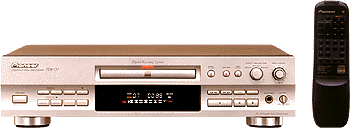Pioneer
October 12, 1998
Pioneer Corporation
Pioneer Debuts Rewritable Compact Disc Recorder
TOKYO, Japan, October 12, 1998 ----- Pioneer Electronic Corporation announced its introduction of the consumer use "PDR-D7" Rewritable Compact Disc Recorder, to the Japanese domestic market.

PDR-D7
| Product | Model No. | S.R.P. | Launch Date |
|---|
| Rewritable CD Recorder | PDR-D7 | ¥124,000 | Oct. 16, 1998 |
| CD-R Blank Compact Disc | RDD-74BJ | ¥700 | Oct. 16, 1998 |
| CD-RW Blank Compact Disc | RDW-74J | ¥2,800 | Oct. 16, 1998 |
< Planning Concept >
Based on the success of the industry's first consumer compact disc recorder, launched in 1995 to the US market, Pioneer has introduced a new re-writable CD Recorder (CD-R & CD-RW) to the Japanese domestic market. This new CD-RW format utilizes the latest type of blank media that is capable of recording up to 74 minutes of audio, as well as being erasable and able to record over again. The PDR-D7 also uses standard consumer CDRs for complete playback compatibility with any conventional CD players.
< Main Features >
1 ) Sampling Frequency Converter
The PDR-D7 features a built-in sampling frequency converter, which allows direct recording from digital sources. Digital sound sources sampled at 48kHz (CS Broadcasting) or 32kHz (BS A-mode Broadcasting) are automatically converted directly into the same sound data at the standard sampling frequency of CDs --- 44.1kHz. Of course, recording can be made from analog sources as well.
2 ) Strategy Control IC
The newly developed "Strategy Control IC" will ensure more accurate recording on blank discs. The CD-R and CD-RW blank discs found in the market today have their own special characteristic, which differ by manufacturer. The Strategy Control IC will work with the Running OPC to adjust the 'laser power' and 'recording strategy' at the most suitable level, to result in a precise recording.
3 ) A Variety of Functions to Allow Easy Operation
- Digital Source Synchro Recording
To simplify recording from a digital source --- DVD, CD, DAT, or MD player --- the recorder automatically starts and stops in synchronization with the source component in either 'one-track' or 'all-track' synchro recording modes. The automatic 'Track Number Writing Function' will automatically write track numbers for both analog and digital sources, ensuring that the discs you record are compatible with standard CDs. - Digital Auto-Fade-In/Out
The "Digital Auto-Fade-In/Out Function" will allow fade-in/out recording of a track with a simple press of a button. 'Fade-in' recording can be operated at any designated point besides the starting of a track. When the blank disc becomes low on recording capacity, the track will be automatically recorded with a 'fade-out' touch for a natural playback (the 'fade-out' touch can be operated also at a designated point). - Automatic Finalizing
The PDR-D7 is equipped with an "Automatic Finalizing Function". Finalization will be made automatically when recording is over. Finalization is the final process of CD-R editing; the stage at which a recorded CD-R disc is made to be playable on ordinary CD players. - SCMS (Serial Copy Management System)
The PDR-D7 incorporates SCMS, which prevents disorderly copying by adding copy inhibit information to the digital signals. With MDs, CDs and DATs that are protected by copyrighting, digital recording is possible with the PDR-D7 for only one generation.
4 ) A Variety of State-of-the-Art Technologies
- Hi-bit Legato Link Conversion
The "Hi-bit Legato Link Conversion" technology applied in the PDR-D7 combines Pioneer developed bit expansion technology with Legato Link for still better musical reproduction. In process of recording and mastering a CD, lower-level signals --- signals lower than least significant bit of a CD's 16-bit system --- are removed. But, the absence of low-level signals causes quantization noise, resulting in a stepped waveform of converted analog signals --- proof that reproduced sound is quite unlike the original. "Hi-bit Legato Link Conversion" restores the lost signals by computing the original waveform from 16-bit data stored on the CD and performing re-quantization in expanded 20-bit data form. This conversion process results in a waveform that is both smoother and closer to the original than conventional technology allows. And Legato Link provides the additional benefit of extending the frequency response to 20kHz to ensure more accurate sound reproduction. - "DAC24" Multi-bit D/A Converter
The newly developed "DAC24" Multi-bit D/A Converter has been applied in the PDR-D7 for an accurate and stable playback or recording. The DAC24 will fully re-produce the digital material that is re-quantized by the 'Hi-bit Legato Link' in a crisp, Hi-resolution sound. The mainstream of DACs are the so-called 'Multi-bit types' or 'Noise-Shaping types' (such as 1-bit DACs), which are both not perfect. 'Multi-bit types' are strong against jitters and can reproduce sounds at a stable level, but they cannot reproduce hi-resolution sounds. On the other hand, 'Noise-shaping types' can reproduce hi-resolution sounds, but are weak against jitters and can easily be interfered by hi-frequency sounds. The "DAC24" is a combination of the two types, which only incorporates their strong points. - Z-Concept
The "Z-Concept" Wide-Range Technology applied in the PDR-D7 realizes a stable signal detection, Accurate signal transmission, and Jitter-free DA conversion. "Z-Concept" ensures that the data is read out from a disc, signals are transmitted form circuit to circuit, and the digital signals are converted into analog, all with significantly improved accuracy.
< Main Features for RDD-74BJ/RDW-74J Blank Disc >
- RDD-74BJ Blank Disc (CD-R)
Recording can be made only once. The recorded CD-R disc has full compatibility with ordinary CD players. (records up to 74 minutes worth of program material) - RDW-74J Blank Disc (CD-RW)
Recording can be made over 1,000 times. Only CD-RW ready recorders and players can playback the recorded CD-RW. (records up to 74 minutes of program material)
< Main Specifications >
- Sampling Frequency
Playback: 44.1kHz
Recording: 48kHz, 44.1kHz, 32kHz - Power Requirements: AC100W
- Power Consumption: 16W
- Dimensions: 420 (W) x 105 (H) x 385 (D) mm
- Weight: 5.4kg
- Frequency Response: 2Hz to 20kHz
- Signal-to-Noise Ratio
Playback: 113dB (EIAJ)
Recording (analog): 92dB (EIAJ)- Dynamic Range
Playback: 99dB (EIAJ)
Recording (analog): 92dB (EIAJ) - Total Harmonic Distortion
Playback: 0.0017% (EIAJ)
Recording (analog): 0.004% (EIAJ) - Wow and Flutter: Unmeasurable (Less than ±0.001%W. Peak)
- Output Voltage: 2.0Vrms
- Digital Coaxial Output: 0.5Vp-p±20% (75Ω) (EIAJ)
- Optical Output Terminal: −15 to −21dBm (wavelength = 660nm)
- Terminals
Analog: Input x 1, Output x 1
Digital: Optical In x 1/Out x 1
Coaxial In x 1/Out x 1



